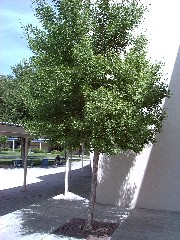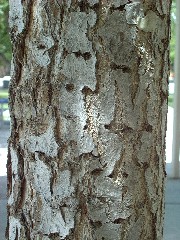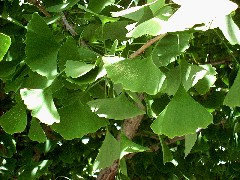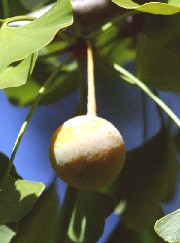Ginkgo or Ginkgo Biloba
Ginkgo bilobaFamily: Ginkgoaceae
Podcast Lyrics
Please click on the pictures below to examine higher quality versions of each of the following.
| Ginkgo Tree |
Ginkgo Bark |
| Ginkgo Leaves |
Ginkgo Fruit Photo Courtesy of Medicinal Plants of the Northwest |
Classification:
Gymnosperm (naked seed), Ginkophyta, deciduousdichotomous venation.
Size:
Ginkgo trees can be small, like the one found by the DHS library, especially in cities where their growth is restricted, but they can also be quite large, when they are left to their own resources. Their normal range is around 60' to 100', and the trunk can range from about two to three feet in diameter.Identifying Features:
- Leafs:
- 2 lobed
- flat
- unique fan-like shape
- green in color except during the fall, when they are a golden-yellow color
- up to three inches long
- petiole reaches the same length
- tend to alternate on larger branches, and cluster on smaller ones.
- Bark:
- greyish/brown color
- many ridges and divots
- because of dichotomous nature, trunk splits continuously and resulting in many vertical trunks rather than one
- Fruit:
- classified as gymnosperms meaning "naked seed"
- only found on "female" trees
- tan/orange color
- very numerous
- become malodorous and squishy in September or October
- do not tend to flower until they are around 20 years old
- Flowers:
- male and female parts are separate; on separate trees
- male has catkins, also known as aments, which are clusters of flowers that hang from the branches and travel with the wind to pollinate the female trees
- female has green, naked ovules
Location/Habitat:
The Ginkgo was originally found in China near areas highly populated by Buddhist monks. The monks had a medicinal interest in the Ginkgo because it has been proven to help with many various health issues. Most likely, the warm weather found in China was what influenced easy Ginkgo growth. From China, it then spread to Japan and Korea, where it was then found by a German scientist by the name of Engelbert Kaempfer. Though the plant now exists plentifully around the globe, China is still considered the Ginkgo's "mother country."Flower/Fruit/Reproduction:
The Ginkgo is dioecious, having separately sexed trees. Males catkins: pollen cones with sporophylls. Females form ovules, two at the end of each stalk. After pollination they develop into seeds. As commonly found in ferns, algae, and moss, ginkgo seeds are fertilized by motile sperm. The sperm use cilia to pull their body along, and once they have reached the archegonia, they fertilize the ovule. Fertilization occurs right before or after the fruit has fallen.Water/Sun Requirements:
The Ginkgo is able to survive in almost any soil, though it grows best in a comparatively dry loam in a place protected from high velocity winds. Some more of the Ginkgo's IDEAL conditions are warm weather, when grown in sunny areas, and with enough water, but it is drought resistant and is said to have survived the Ice Age, so these conditions are not necessary.Special Adaptations:
The Ginkgo tree exhibits some extraordinary qualities when it comes to their special adaptations. Unlike most plants that have restrictions such as plenty of water, or specific soil types, the Ginkgo is seemingly untroubled by these "trivialities." The Ginkgo cannot be harmed by pests or disease. Having lived for millions and millions of years, the Ginkgo is said to have developed a resistance to many things that effect other plants.There are also environmentally helpful qualities that the Ginkgo possesses. The Ginkgo can tolerate heavy pollution, low water supply, and poor-quality soil, allowing them to be a good choice for city plants. Because they are pollution-resistant, they can exist and help reduce carbon dioxide levels. (Generally, only male plants are suggested for this position, however, because the female produces foul-smelling fruit.)
Other Info:
History- The Ginkgo is the oldest existing tree, said to have lived millions of years
- The Ginkgo is known as a "living fossil"
- Because it has remained virtually unchanged for at least 150 million years and might have been growing when the dinosaurs were roaming the earth
- Ginkgo biloba is the only tree that survived after the Hiroshima bombing
- The Tree re-budded without big changes in its structure
Medicinal Uses
- Can be used to:
- enhance memory
- reverse vertigo
- improve blood flow
- protect against oxidative cell damage
- block effects of blood clotting
- and further study may show a link to treatment of Alzheimer's
Culinary Uses
- The nuts found inside the Ginkgo seeds are very popular in Asia and are a traditional part of Chinese cuisine.
- If eaten in too high a quantity, children can sometimes suffer from poisoning.
- When preparing these seeds for consumption, wear gloves because they can cause similar effects as poison ivy.
Reference Sources/Links:
- Ohio Public Library
- Brandeis University
- UConn Plant Database
- The Daily Times
- Ohio State University
- Plants For A Future
- Ezine Articles
- The Ginkgo Pages
- Iowa State University EEOB
- Wikipedia
Jessica C. Per. 6 06/11/2007



